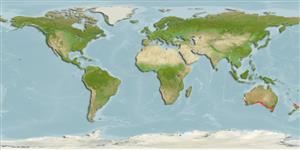Environment: milieu / climate zone / depth range / distribution range
বাস্তুসংস্থান
সামুদ্রিক; ঈষৎ লোনা রীফ সংশ্লিষ্ট; গভীরতার পরিসীমা ? - 90 m (Ref. 9563). Temperate; 26°S - 43°S
Indo-Pacific: Endemic to Australia.
আকৃতি / ওজন / Age
Maturity: Lm ? range ? - ? cm
Max length : 50.0 cm TL পুরুষ/ লিঙ্গ অনিধর্ারিত ; (Ref. 7300)
পৃষ্ঠীয় কাঁটা (মোট ) : 9; পৃষ্ঠীয় নরম পাখনা দন্ড (মোট ) : 14 - 15; পায়ূ কাঁটা : 3; পায়ূর নরম পাখনা্তুন্ড: 14 - 15; কশেরুকা : 26. Adults are silver to brown with black vertical stripes (Ref. 33616).
Juveniles live in estuaries (Ref. 33616) while adults occur in estuaries and on inshore and offshore rocky reefs and seagrass beds (Ref. 9563). Found either in large schools, in pairs or as solitary individuals (Ref. 33616). Neither anterolateral glandular groove nor venom gland is present (Ref. 57406). Reported to have venomous fin spines without associated venom gland (https://fishesofaustralia.net.au/home/species/445#moreinfo).
Life cycle and mating behavior
পরিপক্কতা | প্রজনন | ডিম ছাড়া | ডিমসমূহ | ডিম্বধারন ক্ষমতা | শুককীট
Paxton, J.R., D.F. Hoese, G.R. Allen and J.E. Hanley, 1989. Pisces. Petromyzontidae to Carangidae. Zoological Catalogue of Australia, Vol. 7. Australian Government Publishing Service, Canberra, 665 p. (Ref. 7300)
IUCN Red List Status (Ref. 130435: Version 2024-1)
Threat to humans
Venomous
Human uses
মৎস্য: গৌণ বাণিজ্যিক ; মৎস্যাধার / এ্যাকুয়ারিয়াম : বাণিজ্যিক
হাতিয়ার
Special reports
Download XML
ইন্টারনেট সুত্র
Estimates based on models
Preferred temperature (Ref.
123201): 15.3 - 20.6, mean 17.7 °C (based on 232 cells).
Phylogenetic diversity index (Ref.
82804): PD
50 = 1.5000 [Uniqueness, from 0.5 = low to 2.0 = high].
Bayesian length-weight: a=0.00389 (0.00180 - 0.00842), b=3.12 (2.94 - 3.30), in cm total length, based on all LWR estimates for this body shape (Ref.
93245).
ট্রফিক পর্যায়ে (Ref.
69278): 3.3 ±0.40 se; based on food items.
Fishing Vulnerability (Ref.
59153): Moderate vulnerability (40 of 100).
Nutrients (Ref.
124155): Calcium = 17.9 [7.0, 29.5] mg/100g; Iron = 0.206 [0.104, 0.363] mg/100g; Protein = 19.1 [18.0, 20.2] %; Omega3 = 0.243 [0.127, 0.478] g/100g; Selenium = 11 [5, 27] μg/100g; VitaminA = 30.6 [7.8, 118.3] μg/100g; Zinc = 0.744 [0.478, 1.193] mg/100g (wet weight);
